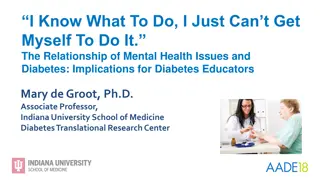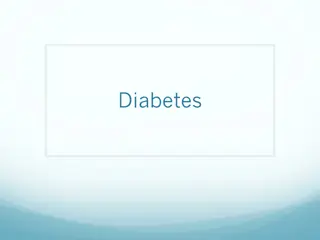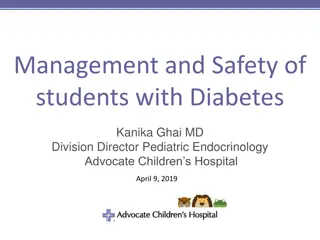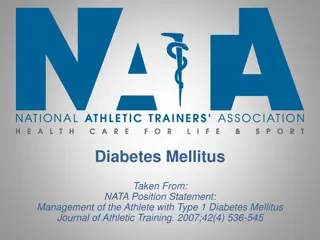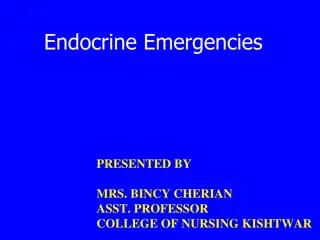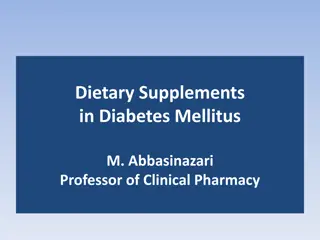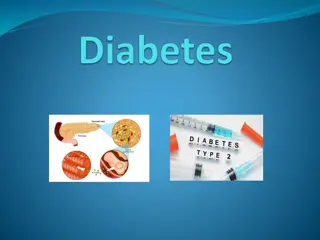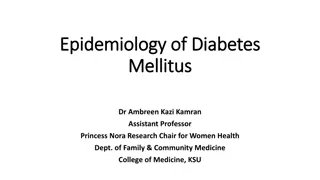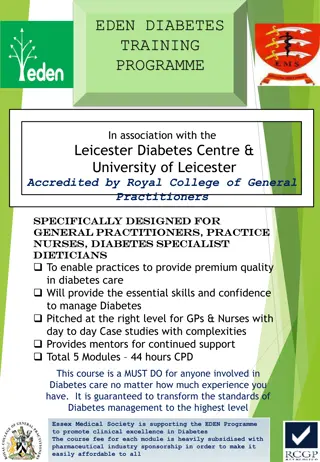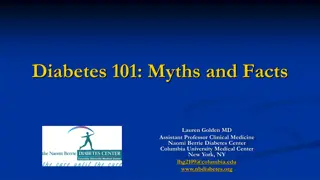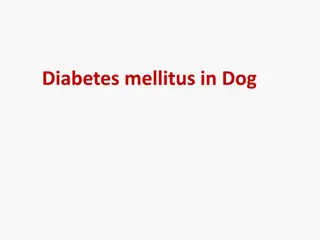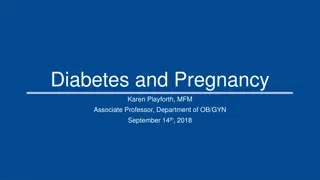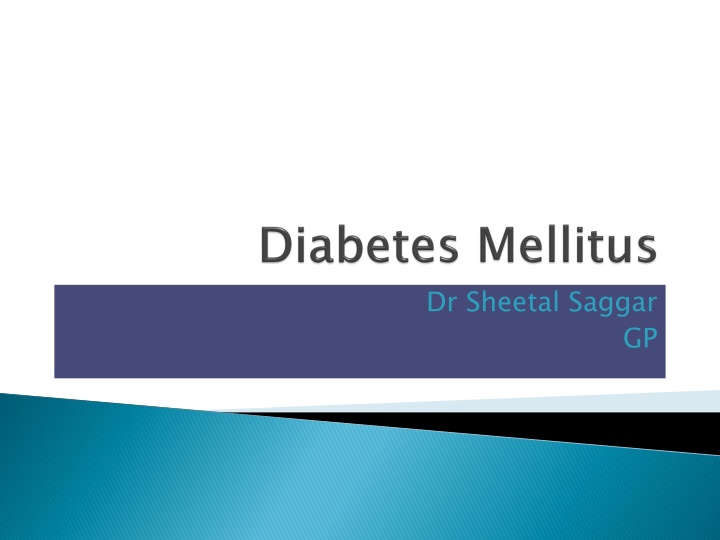
Optimizing Diabetic Patient Care through Integrated Healthcare Approach
Explore the comprehensive approach to diabetic care at Bolton Diabetic Centre, featuring a team of specialists, structured clinics, patient education, and personalized treatment plans. Learn about HbA1c levels, NICE guidelines, new diabetes drugs, CV risk factors, aspirin use, patient involvement in care decisions, and cultural considerations. Understand the importance of structured education, nutritional advice, and tailored patient education programmes to enhance outcomes. Discover demographic-specific data on diabetes prevalence and management strategies for blood sugar control, cardiovascular risk, and microvascular complications.
Download Presentation

Please find below an Image/Link to download the presentation.
The content on the website is provided AS IS for your information and personal use only. It may not be sold, licensed, or shared on other websites without obtaining consent from the author. If you encounter any issues during the download, it is possible that the publisher has removed the file from their server.
You are allowed to download the files provided on this website for personal or commercial use, subject to the condition that they are used lawfully. All files are the property of their respective owners.
The content on the website is provided AS IS for your information and personal use only. It may not be sold, licensed, or shared on other websites without obtaining consent from the author.
E N D
Presentation Transcript
Bolton Diabetic Centre Consultants (4) Specialist Nurses (8) Podiatry Dietetics General Practice Structure of diabetic clinics?? Plan the patient journey.
GP (wI in Diabetes) Practice Nurse Dietition Diabetic Register QOF
1. What level of Hba1c would indicate a diagnosis of diabetes? 2. What is the current NICE target for HbA1c? 3. Name any new drugs that have been introduced recently in the Tx of diabetes? 4. What is the biggest CV risk factor in a diabetic patient? 5. Which diabetic patients should be commenced on aspirin ?
Patients views and preferences integrated into their care Involve the patient in decisions about their individual Target HbA1c level
Offer structured education to every person and/or their carer at and around the time of diagnosis, with annual reinforcement and review Provide individualised and ongoing nutritional advice from a healthcare professional with specific expertise and competencies in nutrition Use the MDT to achieve this!
Ensure the patient-education programmes available meet the cultural, linguistic, cognitive, and literacy needs within the locality
Men > 55 4.3% 10% 10.1% 7.3% 8.2% Men > 55 Women > 55 3.4% 8.4% 5.9% 8.6% 5.2% Women > 55 General Population Black Caribbean Indian Pakistani Bangladeshi
Blood Sugar Control Current treatment Self Management Nutrition Cardiovascular risk Lipids Smoking BP Microvascular Complications Feet Kidneys Eyes
HbA1c BP Smoking Lipids Weight Microalbuminuria Eye and Foot screening
Smoking HBA1C < 6.5 BP Prognosis??? Cholesterol Overweight
WORSE Smoking BP Overweight Cholesterol LEAST BAD HBA1C < 6.5
This is based on the International Diabetes Federation and American Heart Association (AHA) criteria.6 Any three of the following: Increased waist circumference ( 102 cm in men and 88 cm in women; 90 cm in Asian men and 80 cm in Asian women), indicating central obesity Elevated triglycerides ( 1.7 mmol/L) Decreased high-density lipoprotein cholesterol (<1.03 mmol/L for men, <1.29 mmol/L for women) Blood pressure >130/85 mmHg or active treatment for hypertension Fasting plasma glucose level >5.6 mmol/L or active treatment for hyperglycaemia
Diet alone Metformin(consider SU if not overweight, rapid response required, metformin intol or CI) Sulphonylurea Insulin
TZD (glitazones) DPP-4 inhibitor Sitagliptin, Vildagliptin Exenatide
Diet Alone Metformin Consider above in place of SU where sig risk of hypoglycamia OR SU intol/CI Consider above where insulin is unacceptable or inappropriate
TZDs preferable where there is marked insulin insensitivity DPP-4 Inhibitors preferable further weight gain would cause or exacerbate problems Interchangeable where each is not tolerated
Consider where BMI > 35 and problems with high body weight; or BMI <35 and insulin is unacceptable because of occupational implications or weight loss would benefit other comorbidities
Diet Alone Metformin (or SU) SU or DPP4 inhib or TZD Insulin or DPP4 inhib or TZD or exenatide
Acarbose Repaglinide and Nateglinide Sodium Glucose Co-transporter 2 Inhibitors
Reduce glucose reabsorption and increase urinary glucose secretion and proximal convuluted tubule Monotherapy if metformin not approriate Combination Tx with insulin and other antidiabetic drugs (not pioglitazone) Dapagliflozin not recommended for triple therapy, must be canagliflozin or empagliflozin (2015) Beware symptoms of ketoacidosis
structured education continuing telephone support frequent self-monitoring dose titration to target dietary understanding management of hypoglycaemia management of acute changes in plasma glucose control support from an appropriately trained and experienced healthcare professional.
to those on insulin treatment to those on oral glucose-lowering medications to provide information on hypoglycaemia to assess changes in glucose control resulting from medications and lifestyle changes to monitor changes during inter-current illness to ensure safety during activities, including driving.
self-monitoring skills the quality and appropriate frequency of testing the use made of the results obtained the impact on quality of life the continued benefit the equipment used.
Microalbuminuria (ACEI where ACR >2.5 in men and >3.5 in women)
< 140/90 but <130/80 if retinopathy, cerebrovascular disease or microalbuminuria
For a person who is 40 yrs old or over: Initiate therapy with generic atorvastatin 20mg Repeats lipids 1-3 months then annually Target cholesterol < 4 or LDL <2 Note risk in the < 40 yrs age group should still be considered!!
Aspirin is not licensed for the primary prevention of vascular events. If aspirin is used in primary prevention, the balance of benefits and risks should be considered for each individual, particularly the presence of risk factors for vascular disease (including conditions such as diabetes) and the risk of gastrointestinal bleeding
Patient attended last week for Bolton Health Check. Age 56 Overweight BMI=32 Waist=42 Cholesterol=5.6 IHD risk 17% BP 130/85 Hba1C - 43
Fasting Post >7.0 >11.1 Diabetes Mellitus <7 >7.8 <11.1 Impaired Glucose Tolerance 6.1 - 6.9 <7.8 Impaired Fasting Glycaemia Run the consultation...
1 year later. Overweight BMI=32 Waist=40 Cholesterol=5.6 IHD risk 17% BP 130/80 Hba1C - 52 Some thirst Run the consultation
Any Questions? Any Questions?

